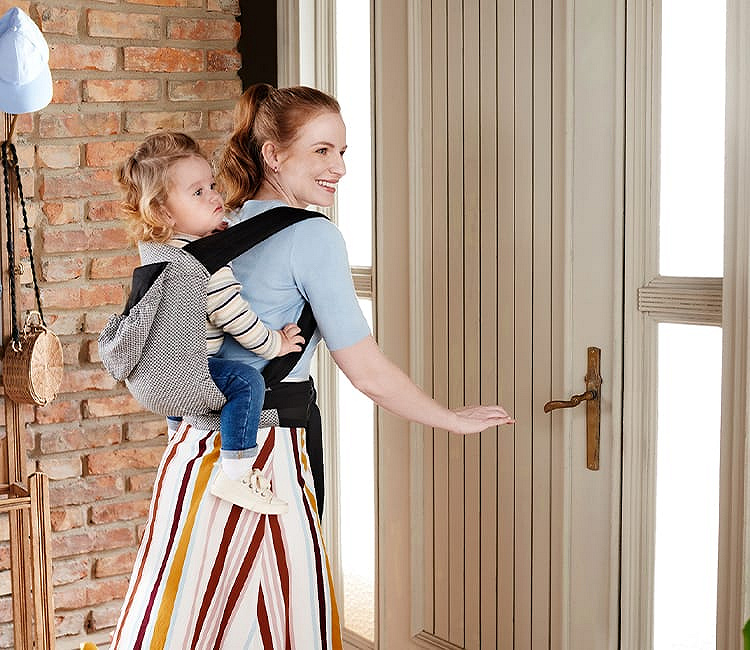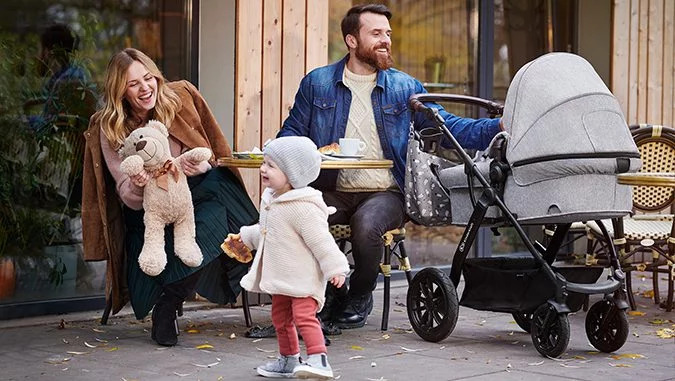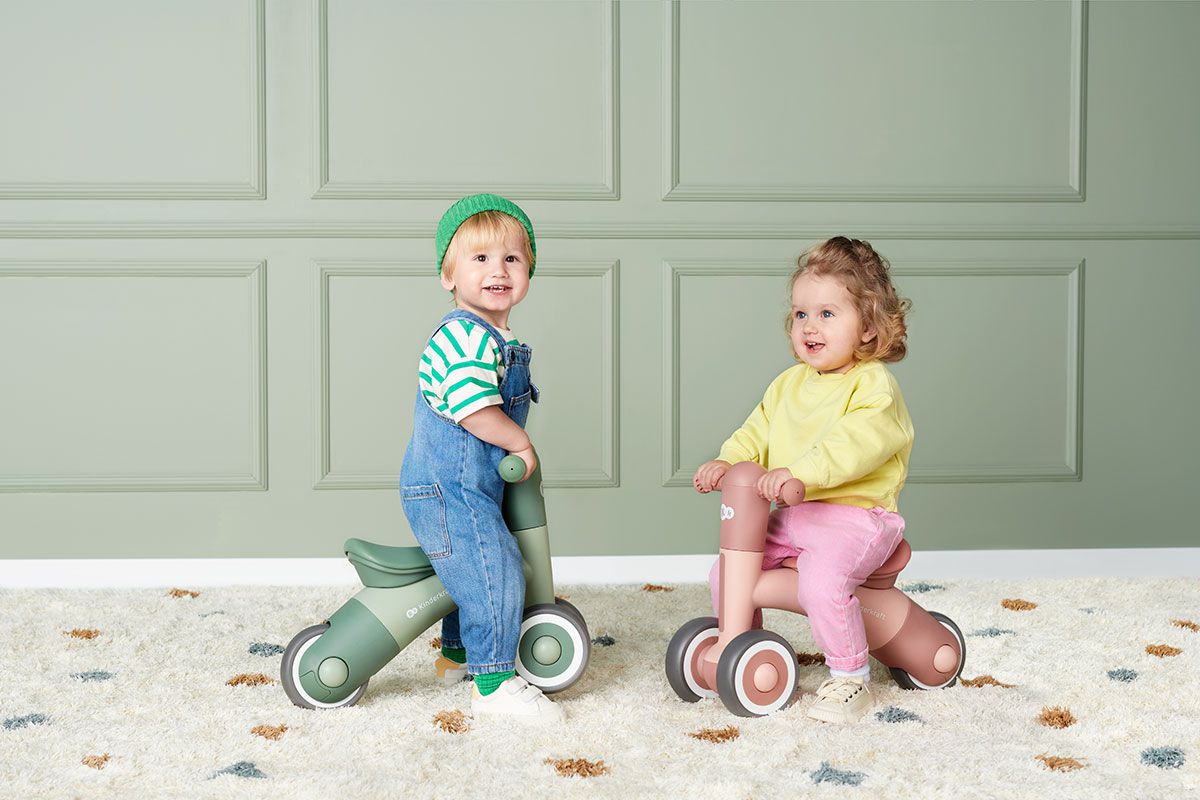What should you dress babies and older children in for walks so they're not too hot?

Should you put a hat on them? Or perhaps take the blanket off? Is your child definitely warm? Or perhaps they're too cold? These are questions that parents constantly ask themselves. But there are ways to quickly find out the answer and avoid making your little one too hot or too cold ever again. This is one way.
What should you dress your baby in for a walk?
A walk should be a time of rest and relaxation, both for you and for your youngster. The key to everything going according to plan is the right clothes for your baby. The right clothes will be comfortable and maintain the right temperature. Your little one shouldn't be either too warm or too cold. But how can you know what they're feeling? There are a few universal rules for dressing babies. One of them is that the child should have one layer more than an adult. The second one says it's better to not put enough on your child than to make them too warm, because overheating is worse for little bodies than not putting enough on (of course, we're not talking about hypothermia). Children who are dressed too warmly may have poorer immunity and be more prone to infections.
To see how warm your youngster is, you can check their temperature at the back of their neck. If your baby is slightly sweaty here, it means that they're wearing too much. But if their hands or feet are a little cool, you should put an extra layer on.
What should a child wear in spring and summer?
When the weather warms up, you can put all thick, down clothes away and replace them with short sleeves and shorts. However, this doesn't mean that that's all your child should be wearing. Everything depends on the weather, and the weather can be volatile. Sudden cool changes can occur even in summer, so the key is to react to current weather conditions.
What are the general rules for dressing babies in spring and summer? A bodysuit is a must, as it ensures protection for the back and chest. It can be a bodysuit with short or long sleeves, depending on the weather. This may be sufficient when it's hot, but in spring you should dress your baby in pants, or even a sweater or loose jacket. Rompers and sleepsuits will also work well. But even this may not be enough, so always have an extra layer on hand in case of a cool change, for example, a thin cotton, muslin or bamboo blanket. In spring, you should also put a thin hat on your youngster (of course, this depends on the temperature). And what about summer? A hat is also a must-have part of the outfit, but in this situation, it should be thin, breathable, and protect against the sun. You can take it off in the shade. Remember that even on warm summer days it's good to have an additional layer of clothing on hand. In addition, in summer, you should also avoid not only your child getting too cold, but also excessive sun exposure. That's why you should buy a pram parasol and cosmetics with UV protection that are suitable for children. In this period, you shouldn't necessarily get rid of your blanket. A lightweight and thin blanket will be great if your little one falls asleep in the pushchair or if the temperature cools.

What should a child wear in winter and autumn?
It's easier to dress your child correctly in winter. It's best to use the so-called onion dressing method, which involves several thinner layers. This makes it easier to remove one to ensure adequate comfort. Start with rompers (ideally with enclosed feet) or a long-sleeved bodysuit and stockings. Next, put on a warm sleepsuit or pants and kimono top or sweater. The following layer should be outerwear, which is used when the temperature drops below 10°C – a pramsuit, possibly a longer jacket (although a pramsuit is much better for young children). If the pramsuit doesn't cover your child's feet, you should put some baby shoes on. Don't forget the head and hands. When the temperature drops to the point where you're also cold, the hands and feet need to be protected with a thick hat (or thin hat and hood) and gloves. When you're putting your baby into the pushchair, remember to have a special leg warmer or thick blanket ready.
In autumn, the weather tends to be more erratic – cool days are intertwined with warm ones. You need to be flexible and adapt to such changes by controlling the thickness of the clothes, and most importantly how your child's body is reacting – if the hands or feet are too cold or if the neck is sweaty. Don't forget about a rain cover for the pushchair, which will provide adequate protection if it rains or snows.
What should your child be wearing depending on the temperature?
There are several rules you should stick to. First, control your youngster's body temperature. It's best to check the back of the neck and the back – if they're dry and warm, it means that your child is dressed appropriately, if they're sweaty, your baby is wearing too much, and if they're cool, you should put an extra layer on. It's also good to check your little one's extremities – if they're too cold, your baby is cold. Second, dress your child like an onion, which means more thinner layers. In this way, you can continuously adjust your youngster's comfort levels by either adding an extra layer or taking one off. Third, keep an eye on your baby's activity levels. They should be wearing something different if they're going to be sitting in the pushchair on the walk than if they're going to be going wild at the playground. Don't let your little one get sweaty or too cold. The fourth aspect is the quality of the clothes. This is very important, as good-quality clothes made from natural materials are much better. They are breathable, more pleasant for the skin, and provide better warmth while preventing sweating.
When on a walk should you cover your child if it's warm?
The answer to this question isn't necessarily simple. It depends on the temperature outdoors and on the thickness of the covering. While obviously no one takes thick blankets out of the wardrobe on hot days, when it's approximately 20°C, a thin blanket can actually be useful. Don't forget that a pushchair carrycot is a limited space that's shielded from the wind, so the temperature inside is slightly higher than that outside. On hot days, you can just cover your baby with a cloth or flannel nappy, or one made from a different material. You should do this only once they fall asleep, as that's when the body starts to cool slightly. In other cases, you can simply not put a cover on.
It's very important to not cover the pushchair with even the thinnest nappy. This turns the pushchair into a glasshouse, which can have similar consequences to leaving your baby in a hot car – the temperature rises rapidly.

What should you dress older children in for walks?
While when it comes to babies, a good rule of thumb is to put one layer more on that you yourself are wearing, in older children, this isn't quite the case, and it depends on their activity levels. If you know that your youngster will be sitting in the pushchair the entire time, you can still follow this rule. But if they're going to be walking with you, they only need as many layers as you're wearing. And if you know that the walk will end in running, it's better to straight away remove one layer compared with what you've put on yourself.
When do you need a hat?
At what temperature should you get rid of a hat on walks? It's difficult to give an unambiguous answer to this question, but some people even think that you shouldn't put a hat on children until temperatures drop below 12°C. A reasonable compromise is to take the hat off at temperatures above 15-16°C in babies who are even just a few weeks old. Remember that even newborns may not need a hat if it's quite warm outside. The recommended temperature in rooms in which your little one is sleeping is 18-22°C, so if the temperature outdoors is the same, you can rest assured that your baby doesn't need a hat. Warm hats shouldn't be used until you yourself feel that it's got significantly cooler outside. Don't forget that overheating can be more dangerous than your youngster being slightly too cold. Hats also come in summer versions and help on hot days. We're obviously talking about breathable hats, often with a visor, that protect your little one against excessive sun exposure. Remember to take it off if your child is in the shade, for example, in the pushchair under a parasol.
